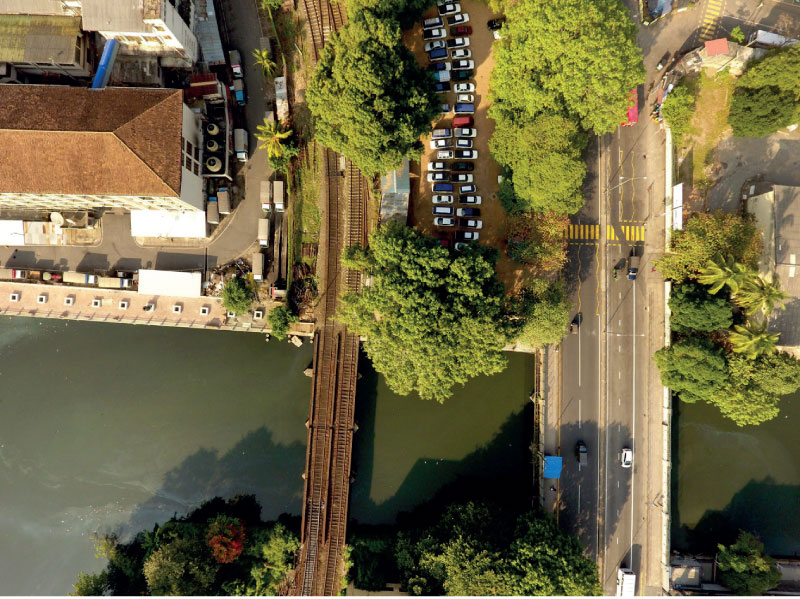Saturday Dec 27, 2025
Saturday Dec 27, 2025
Friday, 25 February 2022 01:32 - - {{hitsCtrl.values.hits}}

Urban agglomerations like Colombo can be particularly vulnerable to heat stress due to the urban heat island effect and high population density
 The world has grown hotter over the past century. According to the World Meteorological Organization, average global temperatures have risen more than 1.1 degrees Celsius since the industrial revolution. Since the 1980s, every new decade has been warmer than the previous one, and 2015-2021 have been the seven hottest years in recorded history. Especially in already hot and/or humid regions, this rapid temperature rise is posing a range of serious and potentially deadly threats.
The world has grown hotter over the past century. According to the World Meteorological Organization, average global temperatures have risen more than 1.1 degrees Celsius since the industrial revolution. Since the 1980s, every new decade has been warmer than the previous one, and 2015-2021 have been the seven hottest years in recorded history. Especially in already hot and/or humid regions, this rapid temperature rise is posing a range of serious and potentially deadly threats.
Heat waves and heat stress can harm human health and wellbeing, reduce productivity and incomes, affect climate-sensitive sectors such as agriculture, and lead to degradation or changes of natural ecosystems. Therefore, it is vital to both understand and address these impacts in proactive ways and shield individuals, households, communities, cities, and industries from excessive, prolonged, and unseasonal high temperatures.
Climate change and global temperature rise
Human activities, particularly in the energy, industry, and agriculture sectors, have greatly increased greenhouse gas emissions and caused a rapid process of global warming. The greenhouse gasses in the atmosphere trap heat and thereby warm the planet, which in turn leads to large-scale and far-reaching climatic changes and more frequent and intense extreme weather events.
Rises in day- and night-time temperatures throughout the year are one of the core elements of climate change, as they are directly related to greenhouse gas emissions and atmospheric warming. This increase in average temperatures can cause heat waves, which are extended periods of abnormally hot weather, and heat stress, which describes a series of overheating conditions caused by high temperatures, such as heat exhaustion, heat cramps, heat rashes, or heat strokes. Particularly in tropical countries like Sri Lanka, heat can occur together with high humidity and reach potentially lethal “wet bulb” conditions that prevent the human body from cooling itself by evaporating sweat.
Heat waves and heat stress directly affect human health and wellbeing. Especially those who are already vulnerable or weakened, such as the elderly, children, or the economically disadvantaged, are at risk of severe health impacts that can worsen chronic conditions such as respiratory or cardiovascular diseases and even lead to death. In addition, changes in average and extreme temperatures can affect the natural environment as well and are associated with many indirect impacts to human lives and livelihoods. For example, most agricultural crops only grow within a narrow band of temperatures and require specific climatic conditions to thrive, putting them in peril when it comes to rising heat and heat-related processes, such as drought or desertification.
Heat waves and heat stress in Sri Lanka
Anthropogenic climate change is set to make heat stress more widespread and severe across the world, with South Asia identified as a critical hotspot. Between 1979 and 2017, extreme combinations of heat and humidity have doubled in much of South Asia. Summer temperatures are projected to increase 3°C–6°C by 2100 in some areas, and around 800 million South Asians are expected to face worse heat waves in the future. Within the region, rising day- and night-time temperatures are predicted to severely impact human health, reduce labour productivity, and pose the threat of lethal heatwaves and wet-bulb temperatures.
Sri Lanka as well is set to face significant impacts related to rising temperatures in the coming decades. According to a World Bank study, approximately 19 million Sri Lankans live in areas that are projected to turn into moderate or severe hotspots by 2050 under a carbon-intensive climate scenario, resulting in a 7-10% reduction of living standards. As Sri Lanka already experiences high temperatures and high humidity, it is important to incorporate heat stress management into policies and action plans and address impacts to health and productivity through social protection schemes and infrastructure development.
In particular, urban areas are highly vulnerable to rising temperatures, whose impacts are exacerbated by population density, air pollution, and the urban heat island effect. Often, cities are hotter than rural areas due to a higher concentration of pavement, buildings, and other surfaces that absorb and retain heat. Based on recent research conducted by the World Bank and the Asian Development Bank, temperatures in Colombo may have already gone up by 1.6 degrees Celsius due to the urban heat island effect, presenting considerable danger to the city’s inhabitants and economy.
In cities such as Colombo, vulnerable groups including the urban poor, women, youth, children, and the elderly face the highest risks to their wellbeing, health, income, and lives. This highlights the need for evidence-based and inclusive action as well as the integration of heat stress considerations into spatial planning, infrastructure and transport, building codes, workplace health and safety, healthcare, social support and insurance schemes, and other interventions.
As climate change progresses and global temperatures continue to rise, it is important to consider the impacts of heat stress on human health, lives, and livelihoods. As outlined above, these impacts can be direct or indirect, take many different forms, and vary based on geography, socioeconomic background, and pre-existing vulnerabilities. Based on scientific evidence and facilitated by national policy and planning processes, Sri Lanka’s cities and economic sectors can adapt to increased heat, protect vulnerable groups, and build lasting resilience.
(The writer works as Director – Research and Knowledge Management at SLYCAN Trust, a non-profit think tank based in Sri Lanka. His work focuses on climate change, adaptation, resilience, ecosystem conservation, just transition, human mobility, and a range of related issues. He holds a Master’s degree in Education from the University of Cologne, Germany and is a regular writer to several international and local media outlets.)